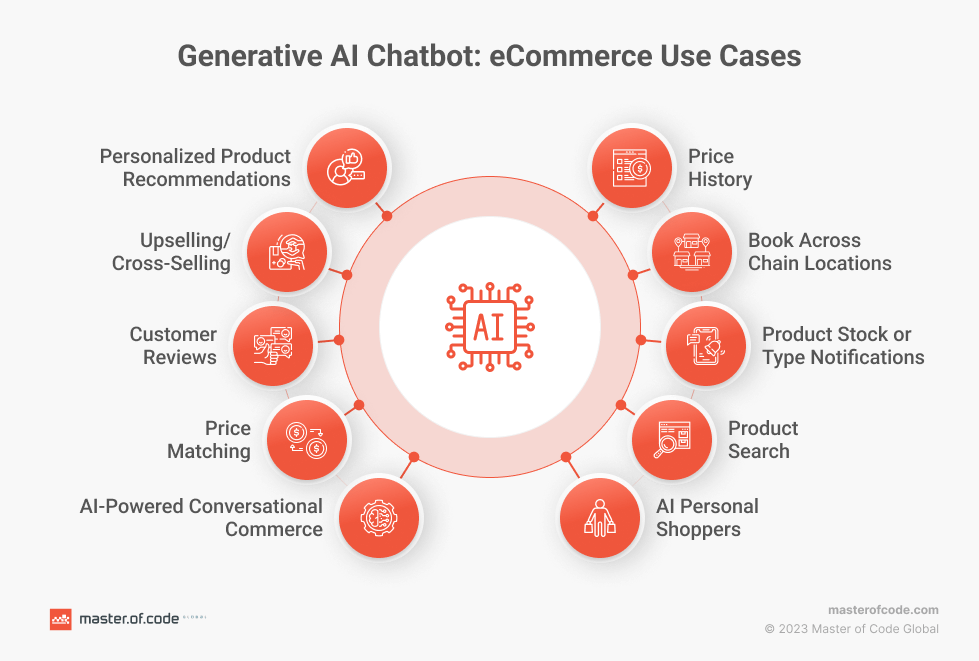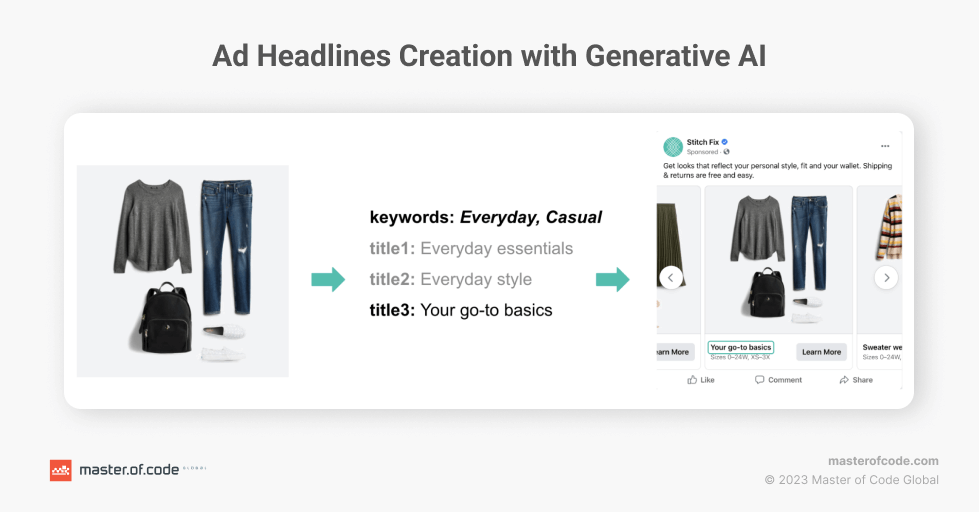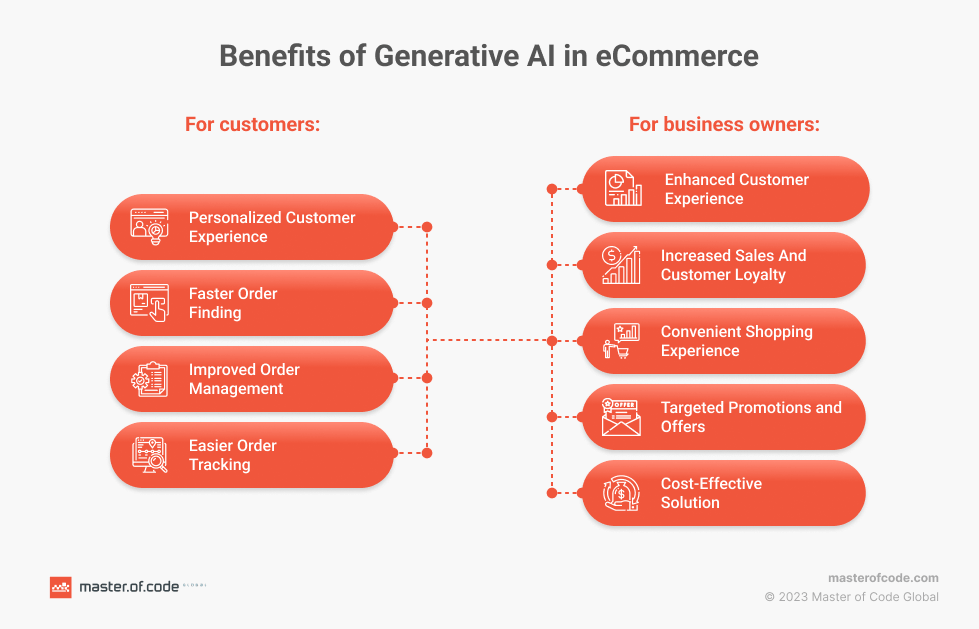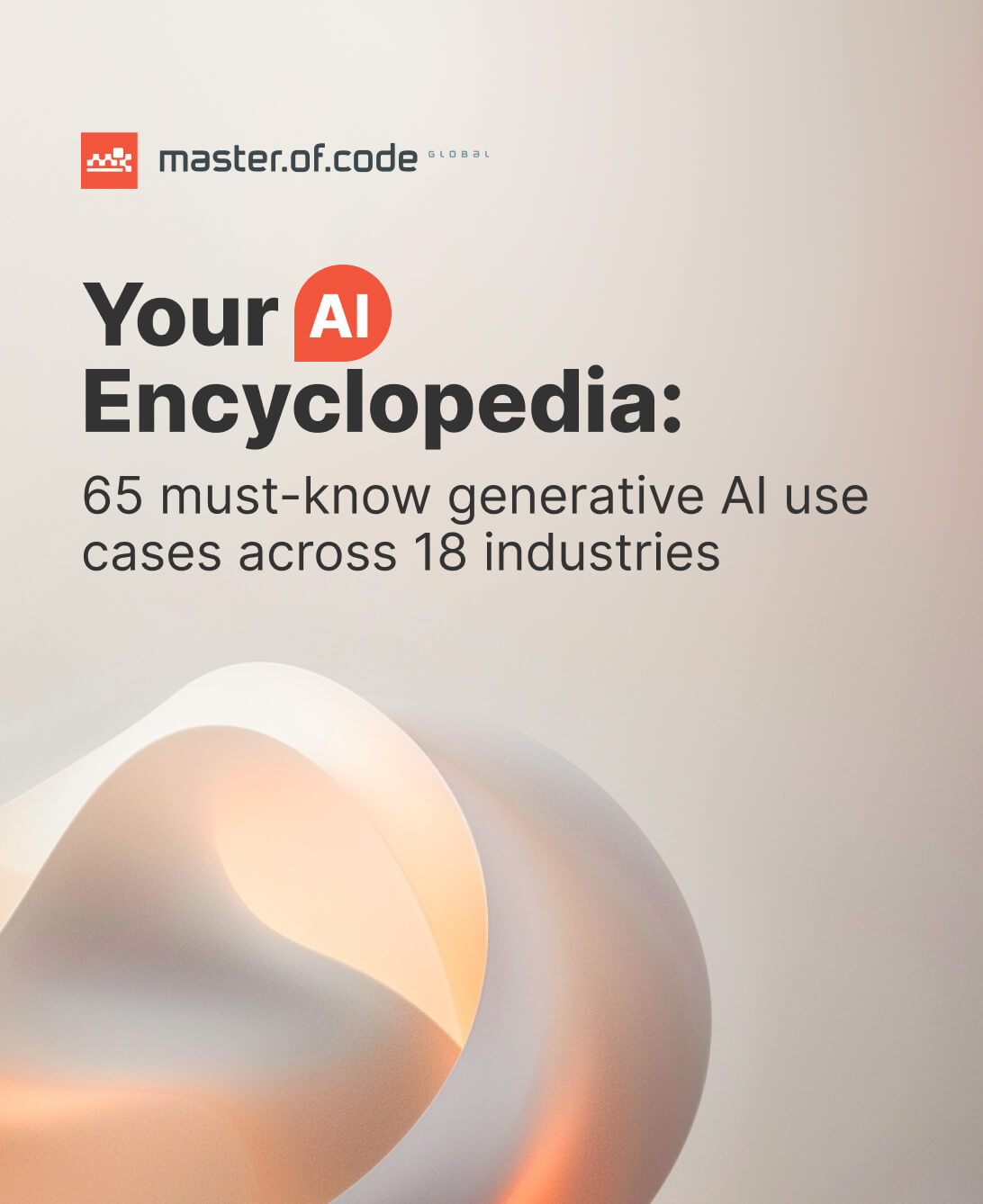Customer expectations are surging and so is the pressure on brands to deliver faster, smarter, more personalized shopping experiences. In 2025, AI in eCommerce goes far beyond basic client service automation. Generative AI into eCommerce practices is now being used to boost product discovery, detect fraud in real time, optimize conversions, and boost retention through unique journeys.
At the heart of this shift? Conversational AI. Text- and voice-based GenAI chatbots and virtual assistants evolve into intelligent digital agents – capable of handling nuanced queries, recommending products in context, and even acting as checkout points inside messaging apps. Whether you’re a small brand or a global enterprise, this technology unlocks scalable, hyper-personalized commerce that feels effortless for the user and highly profitable for the business. Curious how it all comes together in practice? Read the full article to explore real-world use cases and proven results.
Table of Contents
Statistics of Generative AI in eCommerce
- Gen AI is forecasted to reach $2.1 billion by 2032, with a projected annual growth rate of 14.90%.
- AI can increase customer retention with targeted marketing, reinforcing the value of Generative AI for eCommerce retention.
- The top personalization feature for purchase decisions is ‘live search,’ chosen by 42% of respondents. Automated product recommendations based on previous behavior are favored by 35.7%.
- Over 50% of online shoppers now consider a tailored shopping experience important due to post-COVID eCommerce trends.
What is a Generative AI Chatbot?
A generative agent is an advanced type of virtual assistant that can understand natural language, generate human-like responses, and hold dynamic conversations with users. Unlike traditional rule-based bots that rely on pre-written scripts and decision trees, generative chatbots use powerful language models to create responses on the fly, making interactions feel more natural and helpful.
These bots are built on technologies like large language models (LLMs), natural language processing frameworks, cloud computing platforms, and API integration layers. These are Generative AI models trained on vast datasets to understand context, tone, and user intent, allowing them to handle open‑ended queries, customize responses, and even mimic brand voice.
In contrast to standard eCommerce bots that can only guide people through a fixed set of options, generative bots adapt to real-time conversations. They assist with everything from product discovery and order tracking to personalized shopping advice, often improving engagement, satisfaction, and conversions.
Popular platforms that power or support generative assistants include OpenAI (ChatGPT), Anthropic (Claude), Mistral, and Google Gemini. Many eCommerce brands are integrating these technologies to elevate customer help, marketing, and operational efficiency.
Top Generative AI Use Cases in eCommerce
In the following section, we’ll explore various practical use cases of Generative AI, demonstrating its versatility and impact in the domain.

AI-Powered Conversational Commerce
Conversational commerce, fueled by Generative AI, is reshaping how customers interact with online stores. It blends chat, messaging, and voice into seamless, two-way conversations that simplify buying decisions and create highly engaging digital experiences.
Artificial intelligence is also learning shopper preferences in real time and offering tailored assistance – everything from personalized product recommendations to on-the-fly content generation.
For example, HelloFresh uses chatbots to manage customer queries 24/7, helping users choose meals, adjust subscriptions, and get quick answers without needing to wait. These types of tools act like digital shopping guides, guiding people through the journey with smart, human-like interactions that boost satisfaction and drive retention.
AI Personal Shoppers
Buying assistants offer a smart solution to one of eCommerce’s biggest challenges: overwhelming choice. Instead of leaving people to sift through endless options, AI-powered personal shoppers act as digital companions on their path. These helpers allow clients to find what they want and uncover deals they might have missed. Especially for complex, multi-item purchases like outfits or room setups, artificial intelligence ensures the process stays smooth and focused.
Traditional websites tend to treat each search as an isolated interaction, creating a fragmented experience. But with Generative AI, that changes. These intelligent systems learn a user’s preferences as they browse, enabling more cohesive, relevant suggestions across different product categories.
A standout example is Amazon Rufus, the company’s GenAI shopping assistant built into its mobile app. Rufus interacts with customers in natural language, helping them narrow down options, compare products, and make decisions faster, all in one unified experience.
Personalized Product Recommendations
The majority of customers only engages with tailored messaging. That’s why businesses are turning to Generative AI to deliver smarter, more relevant product suggestions. By analyzing behavioral signals and client data in real time, artificial intelligence can craft hyper-customized recommendations that feel intuitive and timely.
These individualized tips are often delivered through product cards in an eCommerce AI chatbot, making it easy to discover items that match their needs, whether they’re searching for something to wear, cook, or gift. A great example of this in action is Sephora’s Virtual Artist, which uses smart algorithms to provide beauty product suggestions based on users’ virtual try-ons. It’s a seamless blend of personalization and interactivity that increases both engagement and sales.
Upselling/Cross-Selling
By analyzing a shopper’s current order in real time, Generative AI in retail can suggest complementary products that align with the buyer’s interests, boosting both convenience and cart value. Through personalized, AI-driven conversations, these interactions mimic the intuitive suggestions you’d get from an in-store associate.
For example, if a customer adds a few skincare items to their cart, a Generative AI for eCommerce chatbot might respond with, “I see you’ve added Product X – many clients also bought Product Y to complete their routine. Would you like to add it to your order?” This tailored approach not only feels helpful, it drives results.
According to Forbes, business leaders report that digital bots have increased sales by 67%. A strong case in point is Rep AI, which integrates with Shopify to deliver real-time, smart product suggestions at checkout, turning casual carts into larger, more profitable purchases.
Customer Reviews
Online feedback plays a pivotal role in purchase decisions – so much so that 49% of consumers trust it as much as personal recommendations, according to BrightLocal. But with responses scattered across platforms, finding trustworthy insights can feel like a scavenger hunt.
Gen AI solves this by pulling reviews from multiple domains, not just the current site. Instead of toggling between Amazon, Wayfair, or niche retailers, users can simply ask a Generative AI-based eCommerce chatbot for a product summary. The bot delivers aggregated ratings, review highlights, and even sentiment trends – all in seconds.
A real-world example of this is Amazon’s Rufus, which uses artificial intelligence to summarize customer feedback directly in the app. It saves shoppers time while helping them make confident, informed decisions.
Price Matching
In today’s hyper-competitive marketplace, price transparency is key. Multichannel sellers often list similar products on the same platform, which can overwhelm buyers with options. That’s where Generative AI steps in. By powering eCommerce bots with intelligent comparison capabilities, businesses can offer real-time price matching across multiple merchants, right inside the chat interface.
Instead of manually checking different listings, shoppers can simply ask the bot for the best deal. The system gathers prices from various sources and displays a clear comparison, making it easy to spot savings.
A great example is Perplexity AI, which enables chatbot-based cross-retailer price comparisons to help people shop smarter. This added convenience builds trust, improves user satisfaction, and nudges hesitant buyers toward confident purchases.
Product Search
Among the most powerful features is the ability to assist users who don’t know exactly what they’re looking for. Generative AI enables bots to interpret vague or descriptive product requests like, “Find me something bohemian, under $100, and good for summer brunches,” and still return spot-on suggestions.
By using natural language processing, these bots understand the shopper’s intent and style preferences, even without exact product names. They then serve up personalized recommendations that align with those criteria.
A standout example is Amazon Rufus, which uses GenAI to process natural language queries and guide users to relevant products quickly and effortlessly.
Product Stock or Type Notifications
Generative AI is also transforming how customers stay informed about product availability. Instead of manually checking back for updates, people can rely on digital assistants to notify them about low-stock items, restocks, or trending offerings in real time. These dynamic notices create a more unique experience, especially when users have previously interacted with an eCommerce chatbot and opted in for notifications.
For instance, Sephora’s Virtual Artist not only helps clients find the right beauty products through virtual try-ons but also alerts them when a favorite shade is back in stock or when popular items are running low. This proactive engagement keeps customers in the loop, drives urgency, and supports higher conversion rates.
Book Across Chain Locations
When scheduling appointments at a business with multiple outlets, artificial intelligence displays available time slots for each branch. Such a practice allows clients to choose their preferred location from the options provided. This applies to various reservations, like haircuts, fitness classes, or restaurant bookings. The approach is particularly useful for those who prioritize date and time over location.
The flexibility given by booking chatbot developed by Master of Code Global for Aveda has resulted in a 7.67x increase in average weekly arrangements since it was launched. It can display real-time availability across all locations, letting users start by locking in the timing, then pick the most convenient branch.
Also, take Sephora’s Virtual Assistant, for example. It enables clients to book in-store beauty appointments directly through chat, organizing the experience and removing friction.
Price History
Generative AI is bringing a new level of transparency to online shopping by embedding cost tracking into eCommerce assistants. These bots can now highlight real-time deals with context, using messages like “lowest price in 30 days” to nudge purchase decisions and build buyer confidence.
By using historical pricing data, the chatbot offers personalized updates that are both helpful and timely. This not only boosts engagement and conversions but also helps reduce returns, as customers feel more informed and assured about the value of their purchase.
A standout example is Rufus from Amazon, which surfaces pricing context during product searches, making the deal feel even more compelling without any added pressure.
Dynamic Pricing Strategies
Generative AI is helping retailers move beyond static price tags and toward real-time, context-aware pricing models. Digital systems analyze variables like demand trends, competitor activity, time of day, and customer behavior to adjust costs dynamically, boosting competitiveness and maximizing profits.
One notable example is Walmart, which has been testing AI-driven dynamic pricing to respond to fluctuations in shopper demand. This allows the retailer to offer more attractive prices during peak interest while protecting margins during lulls – an approach that improves flexibility and increases conversion potential without manual input.
Virtual Shopping Assistants
Today’s buyers don’t just want options – they want guidance. That’s where virtual assistants powered by GenAI come in. These companions act like personal guides, answering questions, suggesting products, and even assisting with checkouts – all in a conversational, human-like way.
Amazon Rufus and the Walmart Chatbot are two leading examples of this trend. Both serve as digital shopping partners that understand natural language and help users find exactly what they need. From comparing similar items to offering contextual recommendations, these assistants optimize the buying experience and improve customer satisfaction at scale.
Automated Content Creation
Manually writing product descriptions and titles for thousands of Stock Keeping Units is a massive drain on time and resources. Generative AI changes the game by automating this process, producing high-quality, SEO-optimized content at scale based on available data and user intent.
Amazon uses this capability through its Rufus assistant, which uses Generative AI to elevate product listings with clearer, more compelling titles and descriptions. This not only improves discoverability and engagement but also guarantees consistency across vast inventories, ultimately speeding up go-to-market time and reducing content production costs.
Product Image Generation
Creating professional product visuals at scale can be costly and time-consuming, especially when trying to showcase variations, environments, or future concepts. Generative Adversarial Networks (GANs) are changing that by enabling brands to produce realistic, AI-generated images that match their design and marketing needs.
IKEA has embraced this approach, using GANs to generate product visuals for its catalogs and advertising materials. These synthetic images allow for creative flexibility, faster asset production, and reduced reliance on traditional photography, helping IKEA keep content fresh while staying cost-efficient.
Virtual Try-On
Trying before buying has gone digital – thanks to AR-powered virtual try-on tools driven by AI. These solutions let customers visualize products like makeup, glasses, or clothing on themselves in real time, improving confidence and reducing purchase hesitation.
A standout example is Sephora’s Virtual Artist, which combines augmented reality with Generative AI to simulate how makeup products will look on different skin tones and facial features. This immersive experience not only elevates engagement but also helps reduce returns by aligning expectations with reality.
Supply Chain & Inventory Management
GenAI isn’t just revolutionizing the front-end shopping journey – it’s transforming back-end operations too. By integrating predictive analytics with real-time data, digital bots can predict trends, manage stock levels, and simplify logistics across the supply chain.
HelloFresh uses such tools for proactive inventory and demand forecasting, ensuring the right ingredients are available at the right time. This precision minimizes waste, avoids stockouts, and optimizes delivery planning, making operations more efficient and customer experiences more reliable.
Advanced Analytics & Insights
Artificial intelligence is turning raw data into real-time perceptions that teams can actually act on. By analyzing user interactions, purchase behavior, and operational metrics, digital analytics delivers clear, insights that support better decision-making across departments.
HelloFresh taps into this potential using the Teneo platform to provide conversational analytics. This allows team members to ask natural-language questions about performance data and get instant, easy-to-understand answers, making business intelligence more accessible and actionable without relying on technical experts.
Market Analysis & Product Development
Gen AI is actively inspiring innovation. By processing consumer feedback, market trends, and behavioral data, digital tools can surface unmet needs and even suggest new ideas, accelerating the concept-to-prototype cycle.
IKEA is using Generative AI in its product development process to ideate fresh furniture concepts based on emerging trends and customer preferences. This not only shortens time-to-market but also makes sure new offerings are aligned with what buyers actually want, making innovation more data-driven and demand-responsive.
Personalized Marketing Campaigns
Generic email blasts are out – hyper-customized, digital campaigns are in. Generative AI enables brands to tailor messaging based on user behavior, preferences, location, and context, dramatically increasing engagement and conversion rates.
Sephora is a prime example, using intelligent tools to deliver targeted offers triggered by in-store beacons and online interactions. Whether it’s reminding a client of a recently viewed product or promoting a location-specific deal, these initiatives feel timely, relevant, and personal, creating deeper connections and driving repeat purchases.
AI-Powered Customer Segmentation
Effective marketing starts with understanding your audience – and Generative AI makes that insight sharper than ever. By analyzing purchase history, engagement patterns, and user behavior, artificial intelligence can group people into precise, dynamic segments that evolve over time.
HelloFresh applies this through predictive segmentation embedded in its chatbot interactions. The AI tailors communication based on each user’s preferences and behaviors, warranting that every message resonates. This real-time personalization improves retention, increases lifetime value, and supports smarter campaign targeting across channels.
Generative AI in eCommerce Case Studies
BloomsyBox eCommerce Chatbot
In a partnership with Infobip, Master of Code Global successfully integrated Generative AI into the BloomsyBox eCommerce chatbot. This bot was developed to create unique and personalized greeting cards. During the campaign, the assistant engaged consumers with daily questions. And the first 150 users who answered correctly were rewarded with a complimentary bouquet.

GenAI integration allowed these winners to generate heartfelt and customized letters for their mothers. These messages ranged from lighthearted to sincere, providing a truly memorable and unique experience for both gift givers and recipients. This innovative use of chatbots with Generative AI showcases how technology may elevate the emotional connection and drive engagement.
Shopify Sidekick
Sidekick is a GenAI bot designed to assist online store owners with various tasks. It is trained to understand and respond to questions related to Shopify’s functionalities and company management. It helps users with setting up discounts, summarizing sales data, and even modifying shop designs. The assistant’s goal is to simplify the time-consuming and repetitive processes involved in managing an online store. It gives personalized responses and assistance that cater to the unique requirements of each user’s business.
Furthermore, Sidekick’s capabilities mirror the ‘co-pilot’ approach promoted by artificial intelligence technology companies like OpenAI and Microsoft. It works as a proactive helper that gathers relevant data from the internet and provides actionable insights. Shopify emphasizes that Sidekick is designed to complement people’s visions and goals. It also assists them in making informed decisions and changes within their online businesses.
Stitch Fix’s AI-Based Ads and Product Descriptions
Stitch Fix uses Generative AI, including models like GPT-3, to enhance its operations. They apply text generation for tasks such as crafting compelling ad headlines and rich product descriptions. AI enables them to rapidly produce brand-aligned content at scale, while human experts review and refine the outputs to ensure high quality.

They also leverage fine-tuning—a technique that trains AI on their unique tone and language. This results in accurate, on-brand narratives across their vast inventory. In tests, the AI-generated descriptions even outperformed those written by humans. Stitch Fix combines artificial intelligence with domain expertise to deliver continuously improving content.
OneClickUpsell: AI-Powered Upsell Revenue Engine
In January 2024, Master of Code Global launched a proprietary Generative AI model for the OneClickUpsell (OCU) application – built from scratch to overcome the limitations of Shopify’s native features. This solution supports both pre-purchase and post-purchase upsell opportunities, dynamically adjusting offers based on shopper behavior and intent.
The results speak for themselves: within the first month, the app generated $6,000 in upsell revenue. By March, that figure surged to $41,000 – marking a 160% monthly growth trajectory. This case shows how purpose-built GenAI tools can become income multipliers when tailored to real-world merchant needs.
Zipify Pages: AI-Enhanced Content Creation for eCommerce
Zipify Pages, developed by Master of Code Global, is a landing page builder designed specifically for Shopify merchants. The platform empowers users to create high-converting, on-brand pages without needing technical or copywriting expertise.
A standout feature is its Generative AI capability for producing compelling product descriptions and site copy in seconds, eliminating weeks of manual content creation. With over 600 five-star reviews and trust from 15,000+ eCommerce brands, Zipify Pages showcases how scalable solutions can drive creativity, speed, and performance across digital storefronts.
ShopJedAI: Generative AI for Smart Commerce & Ad Creation
ShopJedAI, a multifunctional platform developed by Master Of Code Global’s R&D team, combines a smart shopping aid with a powerful ad creation tool. The team built a robust Shopify LLM Assistant using embeddings and a vector database to offer accurate, relevant responses.
This approach doesn’t just help users – it also helps merchants launch high-performing ads with minimal effort. With 86% of queries answered correctly by the chatbot, ShopJedAI proves how intelligent assistants can optimize operations and improve both client experience and marketing ROI.
Zipify Agent Assist: Scaling Support with Smart Automation
To meet Zipify’s growing needs, Master of Code Global created a custom AI solution designed to scale operations without compromising quality. The project included two core elements: an intelligent virtual assistant for support agents and an advanced analytics dashboard.
This assistant helps agents respond to inquiries faster and more accurately, while the dashboard provides actionable insights into user behavior. Together, these eCommerce chatbot examples form a robust infrastructure that boosts efficiency and empowers human teams.
Generative AI Limitations and Ethical Considerations for eCommerce
A combination of GenAI and eCommerce comes with certain constraints and ethical concerns that businesses should handle thoughtfully.
Limitations and Challenges:
- Evaluation and Feedback. Assessing the quality, accuracy, and usefulness of generated content may be tough. Human feedback, although vital, can be subjective, making model improvement a challenge.
- Scalability and Reliability. Integrating Generative AI services comes with technical constraints and content risks that can hinder sustainable growth. It may occasionally produce unexpected or undesirable results, affecting a business’s reputation.
- Quality Assurance. Confirming the accuracy of digital content is crucial to prevent inaccuracies or “hallucinations.” Wrong product information, reviews, or discounts can harm the brand’s reputation.
- Latency. Lag in AI responses may negatively impact user experience. Slow answer times lead to lower conversion rates and revenue loss. Companies need to balance artificial intelligence capabilities with latency considerations.
- Data Quality and Quantity. Generative AI algorithms are only as effective as the data they’re trained on. Incomplete, inconsistent, or biased resources can lead to poor output quality. eCommerce businesses must make sure they have access to high-quality, diverse datasets to train and fine-tune their models effectively.
- Integration Complexity with Existing Systems. Seamlessly embedding GenAI into tech stacks, such as CRMs, ERPs, and legacy platforms, can be technically demanding. Poor integration may limit performance or lead to inconsistent user experiences across channels.
- Resource Intensiveness. Training and deploying advanced systems require significant computational resources, infrastructure, and ongoing maintenance. For smaller retailers, these costs may present a barrier to adoption without external support.
- Dependency and Overreliance on AI. As artificial intelligence becomes more embedded in business operations, there’s a growing risk of excessive dependence. Companies that lean too heavily on automated systems may lose critical human oversight, making them vulnerable to errors or model drift over time.
- Skill Gaps and Workforce Displacement. Implementing Generative AI often requires specialized knowledge in data science, machine learning, and prompt engineering. At the same time, automation may shift or eliminate certain job roles, requiring companies to invest in retraining and change management.
Ethical Considerations:
- Privacy and Security: Generative AI accesses sensitive clients data, posing privacy and security concerns. Safeguarding personal information and offering secure data handling is essential.
- Bias, Fairness, and Accountability: Gen AI can unintentionally reinforce social, cultural, or gender-based prejudice embedded in training data. These biases may lead to skewed recommendations or exclusionary messaging, especially in customer-facing applications. To uphold fairness, businesses must conduct regular audits, diversify training datasets, and warrant human oversight. Clearly defining accountability for AI-driven decisions is also essential to avoid reputational or legal risks.
- Transparency, Trust, and Explainability: Artificial intelligence generates content that often appears human-made, which can create confusion about its source. A lack of transparency may lead users to over-trust or misinterpret AI output. Moreover, many models function as “black boxes,” offering limited insight into how decisions are made – a major issue when explainability is required for compliance or customer assurance. Companies should clearly label AI-generated content, provide context when possible, and invest in systems that can explain how outputs are derived.
To effectively use Gen AI technology in eCommerce, businesses must address these concerns with careful planning, responsible practices, and ongoing monitoring while prioritizing consumer trust and satisfaction.
Benefits of Adding Generative AI to Your Existing Chatbot for eCommerce
Instead of developing a new eCommerce AI chatbot from scratch, Master of Code Global recommends improving an existing bot (if you have one) with this tech. However, if you don’t have one, our team suggests developing a Conversational AI in retail or eCommerce market, specifically designed for your needs. This approach allows for more efficient and cost-effective implementation of technology, while still providing the benefits of a personalized and engaging bot experience for eCommerce clients.

Benefits of Generative AI in eCommerce Chatbots for Business Owners
- Enhanced Customer and User Experience: Artificial intelligence enables assistants to deliver unique, real-time interactions – from tailored product recommendations to loyalty rewards – improving both emotional engagement and functional ease. The result is a more intuitive, rewarding client journey that builds trust and satisfaction.
- Increased Sales and Customer Loyalty: AI-powered agents go beyond answering FAQs – they assist with orders, manage returns, and resolve issues instantly, improving eCommerce customer service. By handling routine requests, they free up human agents for more complex support, boosting overall efficiency.
- Personalized Marketing and Promotions: Generative AI uses customer behavior and purchase history to trigger relevant, high-impact promotions. These bots help maximize ROI during peak shopping moments while raising awareness of upcoming offers and campaigns.
- Convenient Shopping Experience: With natural language processing, AI retail chatbots understand user queries phrased in everyday language, making it easy for shoppers to get what they need without navigating complex menus. One of the standout benefits of an AI chatbot for eCommerce is its ability to offer seamless, self-service shopping experiences on any device or channel.
- Cost Savings and Operational Efficiency: Generative technology reduces the need for large support teams by automating repetitive tasks. It also improves order handling, inventory queries, and supply chain communications, delivering high-quality approaches while cutting costs.
- Streamlined Operations: Digital bots simplify workflows by integrating with eCommerce platforms, CRMs, and back-end systems. This frees internal teams from manual tasks and enables them to focus on innovation, strategy, and customer growth.
- Smarter AI Chatbot Capabilities: Generative AI upgrades assistants with human-like conversational skills, deeper product knowledge, and adaptive learning. These bots can handle nuanced help inquiries, continuously learn from interactions, and boost product discovery through intuitive, unique recommendations, making them more intelligent, efficient, and useful over time.
- Global Reach and Inclusivity: AI agents can support multiple languages, regional preferences, and time zones, enabling businesses to serve a diverse, global audience more effectively. This not only boosts customer accessibility and inclusivity but also sustains global supply chain management by facilitating real-time communication and coordination across markets.
Future Trends for 2025 and Beyond
Immersive Shopping with AI-Powered AR/VR and Voice Assistants
The future of online retail is multisensory. With AR/VR tools and voice assistants, shopping will become more immersive and interactive, enabling virtual try-ons, guided browsing, and seamless voice-enabled purchases from anywhere.
Hyper-Personalization Across the Customer Journey
Generative AI will power holistic customization, adjusting everything from homepage content to delivery options in real time. Every interaction will reflect individual preferences, behavior, and context, raising satisfaction and conversion rates across the eCommerce customer journey.
AI-Enhanced Customer Support and Emotional Intelligence
Chatbots will grow more aware, using sentiment analysis to adapt tone and response style. This next-gen experience will feel less transactional and more human, building stronger client relationships through empathy and relevance.
Smarter Inventory and Supply Chain Management
Real-time data and predictive analytics will give retailers a sharper edge in managing inventory and logistics. AI tools for eCommerce will help forecast demand, balance stock across locations, and optimize last‑mile delivery, improving both cost efficiency and sustainability.
Generative AI in Product Development and Innovation
Retailers will increasingly use artificial intelligence to co-create with consumers, generating design concepts, testing new product ideas, and producing content at scale. This will speed up product cycles and align offerings more closely with customer desires.
Real-Time Fraud Detection and Cybersecurity
AI systems will become proactive safety agents – monitoring transactions for suspicious activity, identifying potential fraud in real time, and automating threat responses. This shift will protect both business operations and user trust.
Responsible AI: Ethics, Governance, and Tech Integration
With great power comes great responsibility. Businesses will need strong governance frameworks to provide transparency, fairness, and compliance. Ethical AI integration will become a competitive advantage, not just a checkbox.
Conclusion
In the dynamic world of eCommerce, artificial intelligence stands as a game-changer. But what numbers talk about the current sector? Let’s take a look:
- 74.7% of consumers favor brands offering personalized experiences.
- 83% of organizations see improved chatbots as the top Generative AI application in commerce.
- 69% of clients are open to using artificial intelligence for better shopping experiences.
- 78% of brands have either implemented or plan to implement AI, highlighting the industry’s dedication to innovation.
Master of Code Global delivers Conversational AI in eCommerce to elevate the customer experience and optimize business operations. Our expertise extends to assisting brands in seamlessly integrating artificial intelligence into their chatbots, ensuring they remain pioneers in this transformative eCommerce landscape.
FAQ
How does Generative AI improve customer engagement and conversion rates in online stores?
Gen AI personalizes every step of the user journey – from product recommendations and search results to tailored messages and promotions. This relevance increases engagement, reduces friction, and nudges shoppers toward faster, more confident purchase decisions, boosting overall conversion rates.
What are the most impactful use cases of Generative AI in eCommerce today?
Top use cases include conversational commerce via chatbots, tailored product recommendations, virtual try-ons, upselling and cross-selling, automated content generation, and smart inventory management. These solutions improve both client experience and operational efficiency.
Can Generative AI help reduce returns and boost customer satisfaction?
Yes. By delivering more accurate product descriptions, personalized sizing or style suggestions, and real-time support, Gen AI helps shoppers make better-informed decisions. This reduces return rates and improves post-purchase enjoyment.
How can eCommerce businesses get started with Generative AI?
Start by identifying high-impact areas like customer service, product discovery, or marketing automation. Then, partner with experienced digital solution providers who understand eCommerce workflows and can integrate AI into your existing stack. Begin with a pilot project and scale based on measurable results.





